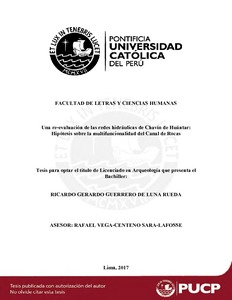| dc.contributor.advisor | Vega Centeno Sara Lafosse, Rafael | |
| dc.contributor.author | Guerrero de Luna Rueda, Ricardo Gerardo | es_ES |
| dc.date.accessioned | 2018-01-30T21:02:17Z | es_ES |
| dc.date.available | 2018-01-30T21:02:17Z | es_ES |
| dc.date.created | 2017 | es_ES |
| dc.date.issued | 2018-01-30 | es_ES |
| dc.identifier.uri | http://hdl.handle.net/20.500.12404/9966 | |
| dc.description.abstract | Chavín de Huántar es uno de los centros ceremoniales más importantes de la era Formativa
de los Andes Centrales (1800 a.C. - 200 d.C.). Desde su revelación al mundo occidental (siglo XVI,)
este monumento arqueológico ha sido distinguido por guardar en su interior estrechos y oscuros
pasajes que corren por debajo de la tierra. Entre ellos destacan las redes de canales subterráneos, y
entre estas, el Canal de Rocas: un largo y complejo sistema que atraviesa longitudinalmente el sitio
arqueológico; interconectándose con las diferentes plazas, plataformas y edificios de la superficie
externa. La presente investigación explica la secuencia de eventos ocurridos en uno de esos canales
subterráneos, el ramal RL.02: conducto que atraviesa de lado a lado la Plaza Circular, el espacio
abierto más importante del santuario. Para el establecimiento de esta secuencia se actualizó la
sistematización de la red, se realizó un análisis cualitativo de la arquitectura, un análisis
estratigráfico y un análisis tipo-serie de la evidencia alfarera. La interrelación de los resultados
sirvió para comprender la historia de este ramal RL.02, desde el momento de su construcción, hacia
el 800 a.C., hasta su inhabilitación en tiempos Recuay, alrededor del 200 d.C. Estas inferencias
fueron conjugadas con los antecedentes del Canal de Rocas con el objetivo final de identificar, de
manera preliminar, las principales funciones que tuvo este complejo y sofisticado sistema hidráulico
durante la época Chavín, y los usos que se le dio en la época Recuay. | es_ES |
| dc.description.abstract | Chavín de Huántar is one of the most important ceremonial centers of the Formative Era of
the Central Andes (1800 BC – 200 AD). Since your revelation to the western world (century XVI) this
archaeological monument has been distinguished by contain in its interior narrow and obscure
passages underground. Among them stand out the network of subterranean canals, and among them,
the Rocas Canal: a long and complex system than runs through the whole archaeological site;
interconnecting the different plazas, platforms and buildings of the exterior. The present research
explain the sequence of events occurred in one of these subterranean canals, the branch RL.02: a
duct that runs side by side the Circular Plaza, the open space more important of the sanctuary. To
the establishment of the sequence we actualize the systematization of the network, we did a qualitative
analysis of the walls, a stratigraphic analysis and a type-serie analysis of the ceramic evidence. The
interrelation of the results serve to comprehend the history of the branch RL.02, since the moment of
its construction, around 800 BC, until the time Recuay made unable to use, around 200 AD. These
inferences were put it together with the antecedents of the Rocas Canal with the final objective to
identify, preliminarily, the main functions that had this complex and sophisticated hydraulic system
during Chavín epoch, and the uses that had during the Recuay epoch. | es_ES |
| dc.language.iso | spa | es_ES |
| dc.publisher | Pontificia Universidad Católica del Perú | es_ES |
| dc.rights | Atribución-NoComercial-SinDerivadas 2.5 Perú | * |
| dc.rights | info:eu-repo/semantics/openAccess | es_ES |
| dc.rights.uri | http://creativecommons.org/licenses/by-nc-nd/2.5/pe/ | * |
| dc.subject | Chavín, Cultura--Restos arqueológicos | es_ES |
| dc.subject | Arqueología--Perú | es_ES |
| dc.subject | Ancash--Restos arqueológicos | es_ES |
| dc.title | Una re-evaluación de las redes hidráulicas de Chavín de Huántar: hipótesis sobre la multifuncionalidad del Canal de Rocas | es_ES |
| dc.type | info:eu-repo/semantics/bachelorThesis | es_ES |
| thesis.degree.name | Licenciado en Arqueología | es_ES |
| thesis.degree.level | Título Profesional | es_ES |
| thesis.degree.grantor | Pontificia Universidad Católica del Perú. Facultad de Letras y Ciencias Humanas | es_ES |
| thesis.degree.discipline | Arqueología | es_ES |
| renati.advisor.dni | 07614173 | |
| renati.advisor.orcid | https://orcid.org/0000-0001-8519-3590 | es_ES |
| renati.discipline | 222016 | es_ES |
| renati.level | https://purl.org/pe-repo/renati/level#tituloProfesional | es_ES |
| renati.type | http://purl.org/pe-repo/renati/type#tesis | es_ES |
| dc.publisher.country | PE | es_ES |
| dc.subject.ocde | http://purl.org/pe-repo/ocde/ford#6.01.01 | es_ES |






